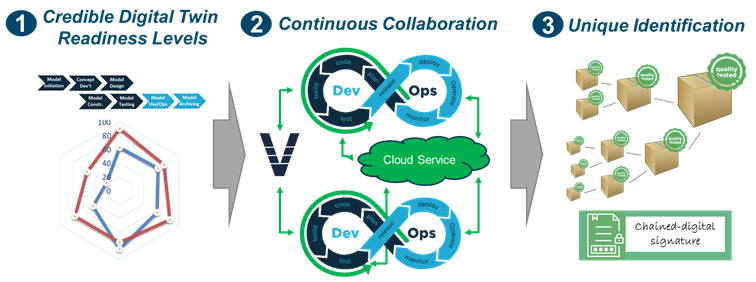Key Elements for Credible Digital Twins
For providing Credible Digital Twins, the UPSIM Project proposes a three-layered solution approach for ensuring credibility and trust in system modelling and simulation for unleashing broad scale economic value.
1. Credible Digital Twin Readiness Level
Modelling and Simulation is mainly practiced in parallel to real testing and preliminary represents a sort of support action, where the ‘high priests’ of simulation are ‘owning’ the dedicated models and simulations. UPSIM is following the concept of Simulation Governance and extends its approach for Credible Digital Twins. This goes in-line with the continuous determination and monitoring of the Modelling & Simulation quality from ‘function-to-simulation’ and therefore a generic Digital Twin Readiness Level will be defined. As Simulation Governance has to be implemented individually for each kind of products, UPSIMs aim is to provide reference processes (a kind of best practices) and an according process assessment model for evaluation of company specific process implementation, including capability levels. This approach ensures a quality assurance for Digital Twins along the product lifecycle and goes in-line with currently available and industrial accepted approaches, like e.g. ASPICE for development of automotive embedded software.
2. Continuous Collaboration
Modern and smart products are typically created by aggregation of subsystems cooperating so that the system is able to deliver the overarching functionality. Typically, the OEM is responsible for the integration task, where the subsystems or components are delivered by 3rd parties or suppliers. For enabling a collaborative development of Credible Digital Twins, UPSIM is extending the reference processes defined in Solution Layer 1 by collaboration processes (patterns) for ensuring a continuous monitoring of the distributed simulation artefact developments. For traceability, documentation and ensuring the overarching functionality model-based system development approaches are used and introduced for Modelling & Simulation. Furthermore, industrial-proven approaches (Continuous Integration) from agile software development will be utilized for supporting a high level of automation and test-driven development of Credible Digital Twins, providing a solid infrastructure for versioning, testing, reporting and a continuous maturity evaluation via the defined Digital Twin Readiness Level. Continuous Integration is also identified as the most promising concept for incorporation of suppliers within development.
3. Unique Identification
Confidence in simulation artefacts is usually quite low in practice. UPSIM addresses this problem by introducing the Solution Layers 1 and 2 for arguing and verifying Digital Twins credibility. In the event of achieving the requested level of its Digital Twin maturity, based on the Digital Twin Readiness Level introduced, the related simulation artefacts have to be uniquely identified. The concept of a ‘digital signature’ for simulation artefacts is identified as a reasonable solution. As different stakeholders are providing dedicated (pieces) artefacts and the artefacts depends on each other, a chained way of unique identification is introduced. Therefore, UPSIMs Solution Layer 3 covers the elaboration of the ‘chained digital signature’ concept and the realization of a block-chain based Distributed Public Key Infrastructure for handling Credible Digital Twins. This unique identification of the simulation artefacts corresponding to the different maturity levels of Credible Digital Twins over product lifecycle will also engage a confident usage of simulations from 3rd parties, enabling the concept of Credible Simulation Applications, briefly spoken credible SimApp’s.
